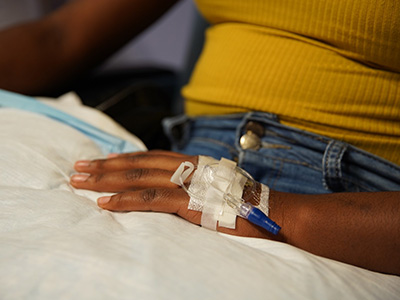Condition
Pediatric Asthma
Pediatric Asthma Care at Children’s National Hospital
Children’s National is a focal point of acute asthma care in the Washington, D.C., area. In fact, Children’s takes care of 1 percent of all the pediatric patients seen in emergency departments for acute asthma care every year in the entire nation. We use a patient- and family-focused clinical care pathway for acute care that uses the latest advances in breathing treatments, all delivered by a dedicated team of pediatric nurses, respiratory therapists and emergency medicine physicians. Children’s has an array of services available for patients with acute asthma, ranging from short stay units to intensive care.
Learn more about asthma in children:
Frequently Asked Questions
H2: Facts about asthma in children
According to the latest information available from the American Lung Association, the Centers for Disease Control and Prevention (CDC) and the National Institute of Allergy and Infectious Diseases (NIAID):
- Approximately 20.3 million people in the United States have been diagnosed with asthma, with at least 6 million of them children under the age of 18
- Asthma is the leading, serious, chronic illness among children in the United States
- Asthma accounts for 14 million absences from school each year
- Asthma is the third-ranking cause of childhood hospitalizations under the age of 15
What causes asthma in children?
The exact cause of asthma is not completely known. It is believed to be partially inherited, but it also involves many other environmental, infectious and chemical factors.
After a child is exposed to a certain trigger, the body releases histamine and other agents that can cause inflammation in your child's airways. The body also releases other factors that can cause the muscles of the airways to tighten, or become smaller. There is also an increase in mucus production that may clog the airways.
Some children have exercise-induced asthma, which is caused by varying degrees of exercise. Symptoms can occur during, or shortly after, exercise. Each child has different triggers that cause the asthma to worsen. You should discuss this with your child's physician.
The changes that occur in asthma are believed to happen in two phases:
- An immediate response to the trigger leads to swelling and narrowing of the airways. This makes it initially difficult for your child to breathe.
- A later response, which can happen 4 to 8 hours after the initial exposure to the allergen, leads to further inflammation of the airways and obstruction of airflow.
H1: What are the symptoms of asthma in a child?
The following are the most common symptoms of asthma. However, each child may experience symptoms differently. Symptoms may include:
- Coughing (either constant or intermittently)
- Wheezing (this is a whistling sound that may be heard while your child is breathing)
- Trouble breathing or shortness of breath while your child is playing or exercising
- Chest tightness (your child may say his/her chest hurts or does not feel good)
- Fatigue
- Nighttime cough
- Noisy breathing
The symptoms of asthma may resemble other problems or medical conditions. Always consult your child's physician for a diagnosis.
Who is at risk for developing asthma?
Although anyone may have asthma, it most commonly occurs in:
- Children by the age of 5
- Child with a family history of asthma
- Children who have allergies
- Children who have exposure to secondhand tobacco smoke
What happens during an asthma attack or asthma exacerbation in a child?
Children with asthma have acute episodes when the air passages in their lungs become narrower, and breathing becomes more difficult. These problems are caused by an over-sensitivity of the lungs and airways.
-
The lungs and airways overreact to certain triggers causing:
- The lining of the airways to become inflamed and swollen
- Tightening of the muscles that surround the airways
- Increased production of mucus
- Breathing becomes harder and may hurt
- There may be coughing
- There may be a wheezing or whistling sound, which is typical of asthma. Wheezing occurs because of the rush of air which moves through the narrowed airways
H2: How do you assess a child for asthma?
To diagnose asthma and distinguish it from other lung disorders, physicians rely on a combination of medical history, physical examination and laboratory tests, which may include:
-
Spirometry: a device used by your child's physician that assesses lung function. Spirometry, the evaluation of lung function with a spirometer, is one of the simplest, most common pulmonary function tests and may be necessary to:
- Determine how well the lungs receive, hold, and utilize air
- Monitor a lung disease
- Monitor the effectiveness of treatment
- Determine the severity of a lung disease
- Determine whether the lung disease is restrictive (decreased airflow) or obstructive (disruption of airflow)
- Peak flow monitoring (PFM): a device used to measure the amount of air a person can blow out of the lungs. During an asthma or other respiratory flare up, the large airways in the lungs slowly begin to narrow. This will slow the speed of air leaving the lungs and can be measured by a PFM. This measurement is very important in evaluating how well or how poorly the disease is being controlled.
- Chest x-rays: a diagnostic test that uses invisible electromagnetic energy beams to produce images of internal tissues, bones and organs onto film.
- Blood tests: analyze the amount of carbon dioxide and oxygen in the blood.
- Allergy tests
What causes childhood asthma?
The majority of children with asthma have allergies. Even exposure to low-grade allergens (those that do not cause significant allergic reactions) may increase the severity of a child's asthma. In addition, allergies may play a role in undiagnosed asthma cases. Other triggers of childhood asthma may include:
- Upper respiratory infections (i.e., colds)
- Inhaled irritants, such as secondhand smoke
- Certain weather conditions, such as cold air
- Physical expressions of emotion, such as crying, laughing or yelling
However, with proper management of the asthma, such as avoiding triggers, taking prescribed medications, monitoring for warning signs, and knowing what to do during an asthma attack, a child with asthma can conduct a healthy and active lifestyle.
H1: Do children outgrow childhood asthma?
How asthma will affect a child throughout his/her lifetime varies, depending on the child. For some children, asthma improves during the teenage years, while others have symptoms that become more severe over time. About half of the children who have asthma at a young age appear to outgrow it, although the asthma symptoms may reappear later in life.
H2: What are the triggers that can cause an asthma attack?
According to the National Institute for Allergy and Infectious Diseases, the American Academy of Allergy, Asthma and Immunology and other organizations, triggers for asthma include:
Allergens
- Pollen
- Mold
- House dust/dust mites
- Cockroaches
- Certain foods
- Animal protein (dander, urine, oil from skin)
Respiratory Infections and Sinusitis
- Infections can cause irritation of the airways, nose, throat, lungs, and sinuses, and worsens asthma
Irritants
- Strong odors and sprays, such as perfumes, household cleaners, cooking fumes, paints, and varnishes
- Chemicals such as coal, chalk dust or talcum powder
- Air pollutants
- Changing weather conditions, including changes in temperature, barometric pressure, humidity, and strong winds
- Chemical-exposure on the job, such as occupational vapors, dust, gases, or fumes
Sensitivity to Medications
-
Medications, such as aspirin and sulfites, may cause asthmatic attacks as a result of sensitivities or allergies to them. These medications often include:
- Aspirin
- Other non-steroidal anti-inflammatory medications, such as ibuprofen, indomethacin, naproxen
- Sulfites used as preservatives in food and beverage Before giving your child any medication, including over-the-counter medications, talk with your child's physician.
Exercise
- Exercise can trigger an asthma attack, often because of the inhaled cool and dry air. Long-term strenuous activities such as long distance running, are most likely to induce asthma, and swimming is the least likely.
Gastroesophageal reflux
- GERD, a condition characterized by persistent reflux of stomach acids, is common in individuals with asthma. Symptoms may include heartburn, belching or spitting up in infants.
Smoke
- Tobacco smoke, whether directly or passively inhaled, has been shown to worsen asthma.
- Wood smoke from wood-burning heating stoves and fireplaces can release irritating chemicals such as sulfur dioxide.
Emotional Anxiety and Nervous Stress
- Reactions from stress and anxiety are considered to be more of an effect than a cause. They can cause fatigue, which may affect the immune system and, in turn, increase either asthma symptoms or bring on an attack.
H3: How to avoid asthma triggers in a child
Many things can trigger an asthma episode, including the following:
- Upper respiratory infections
- Allergies to dust mites, pollens, animal dander, mold/mildew, or cockroaches
- Exercise
- Irritants such as cigarette and other forms of smoke, strong odors and perfumes, fumes from wood stoves or kerosene heaters, and air pollution
- Weather changes
The following is a list of things you can do to limit your child's exposure to common triggers of asthma.
-
Allergies
- Dust mites: The allergy is caused by tiny insect-like creatures called dust mites. Dust mites are found in mattresses, carpets and upholstered furniture. They thrive in warm, humid conditions and feed on the shed scales of human skin. The best way to prevent allergy symptoms caused by dust mites is to limit your child's exposure. Be sure to pay special attention to the bedroom where your child spends the most amount of his/her time.
- Beds: Every bed in your house should have wooden or metal frames. Do not allow your child to sleep on a couch, sofa or hide-a-bed. If your child has asthma and sleeps in a bunk bed, he/she should sleep in the top bunk.
- Mattress/box spring: Place all mattresses and box springs in a zippered, dust-proof cover and tape over the zippers with electrical or duct tape.
- Pillows: Encase pillows in zippered, dust-proof covers. Pillows should be made of Dacron or other synthetic fiber. Do not use foam, feather or Down pillows.
- Bedding: Avoid wool or down blankets. Wash all bedding (sheets, pillowcases, blankets) in hot water. Cold water will not kill the dust mites. Dry all clothes and bedding in the dryer to avoid pollen sticking to them when on a clothesline.
- Floor coverings: If possible, remove wall-to-wall carpeting. If not, vacuum the carpet frequently (at least twice a week). If your child has asthma, only vacuum when your child is away and will not return to the room for several hours after you have finished. Substitute multi-layered vacuum bags for regular single-layer bags. Small, washable cotton rugs may be used if washed often. Wood, tile, or vinyl flooring without a rug is best, and they should be mopped at least weekly.
- Closets: Remove all stored toys, boxes and other articles from closets. The closet should contain only clothing and should be as dust-free as the room. Keep all clothes in closets, never lying around the room.
- Furnace (heating): Electric or gas heat is recommended. Do not use wood stoves or kerosene heaters. Change the air filters on the furnace every month. Cover all furnace outlets in the room with special filters or cover the outlets with ten thicknesses of cheesecloth or muslin. This will catch dust in the furnace air. Change the cheesecloth when it gets dusty underneath (about every two weeks).
- Air purifier: A HEPA filter unit of the proper size can effectively remove airborne allergens.
- Air conditioners: Window unit or central air-conditioning is ideal. Change or clean all filters every month. Windows should be kept closed, especially in the summer.
- Doors: Keep bedroom closet doors and bedroom doors closed as much as possible.
- Walls: Paint walls or use washable wallpaper. Avoid pennants, pictures, wreaths, flower arrangements or other dust catchers on the walls.
- Window coverings: Avoid heavy curtains and Venetian/mini blinds. Use window shades instead. If curtains are used, they should be washed monthly in hot water.
- Humidifier: Avoid the use of humidifiers, dust mites grow best in high humidity. Use a dehumidifier to keep humidity in the home less than 50 percent.
- Furniture: Remove all upholstered (stuffed) furniture and replace upholstered furniture with wooden or plastic furniture. Avoid open bookshelves, as they are great dust catchers.
- Sleeping and napping: Your child should nap or sleep only in his/her own bed, which has been made dust-free. When your child travels or visits, he/she should take a non-allergic pillow with him/her.
- Playing: If your child has asthma, do not allow him/her to jump on furniture or beds nor wrestle on carpeted floors. Avoid fabric toys or stuffed animals. If your child has stuffed animals they should be machine-washable and washed in hot water or placed in the freezer overnight at least weekly. Store toys in a closed toy chest.
- Pollens: In many areas, pollens can be a problem from February through November each year. If your child is allergic to pollen, during pollen season it is important that you keep all car/house windows closed and use the air conditioning.
- Animal dander: Pets that have fur or feathers often cause allergy troubles. If your child is allergic to animal dander (the skin of the animal), it is best not to have pets and not to visit homes where these types of pets are kept.
- Mold/mildew: Mold and mildew grow in areas that are dark, humid, and have poor ventilation.
- Outdoors: Avoid damp, shady areas. Remove fallen leaves and avoid cutting the grass.
- Bathrooms and kitchens: Always use the exhaust fans when cooking or bathing. If you do see mold/mildew, clean the area with cleansers made with bleach.
- In the house: Use the air conditioner. Avoid using humidifiers, as mold/mildew can grow in the water tank. If you must use a humidifier, clean it daily with a bleach and water solution. Reduce indoor humidity to less than 50 percent; use a dehumidifier, if needed. Empty and clean the dehumidifier daily.
- Cockroaches: Some people are very allergic to the substance the cockroach leaves behind. Cockroaches are very common in warm climates and in homes of people living in the city. However, even in climates with much cooler temperatures, the use of central heat allows the cockroaches to live. To avoid exposure to cockroaches, it is best to use roach traps or a professional exterminator.
- Exercise: Even though exercise is a common asthma trigger, your child should not limit his/her participation in sports/exercise, unless directed by a physician. Exercise is good for your health and lungs. Some forms of exercise such as running long distances and playing basketball may be harder for your child to do. Activities such as swimming, golf and karate are good choices for children with asthma. However, persons with asthma should be able to participate in most physical activities. Always make sure your child has a warm-up and cool-down period before and after exercise. Using a reliever medication 15 to 20 minutes before starting exercise can be very helpful, as directed by your child's physician. Consult your child's physician about exercise and asthma if this is a problem for your child.
- Irritants
- Smoke: Do not allow family and friends to smoke anywhere inside the house. Do not allow smoking in the car at any time. Smoke is very irritating in an enclosed area and its odor may be trapped in the car's upholstery for a long period of time and continue to trigger symptoms. When eating out, always sit in non-smoking sections of restaurants. You should also have non-smoking childcare providers.
- Strong perfumes/odors: Your child should avoid things that have a strong smell such as cleaning products, perfumes, hair spray, tar, fresh paint, gasoline, insect sprays, and room deodorizers.
H2: Treatment for asthma in children
Specific treatments for asthma are based on:
- Your child's age, overall health and medical history
- Extent of the disease
- Your child's tolerance for specific medications, procedures or therapies
- Expectations for the course of the disease
- Your opinion or preference
As of yet, there is no cure for asthma. However, asthma can be controlled with prescription medications that may help to prevent or relieve symptoms, and by learning ways to manage episodes.
H1: Managing asthma in children
People with asthma can learn to identify and avoid the things that trigger an episode, and educate themselves about medications and other asthma management strategies. According to the Guidelines for the Diagnosis and Management of Asthma, published by the National Heart Lung, and Blood Institute:
-
Asthma is a chronic disease. It has to be cared for all the time - not just when symptoms are present.
- The four parts of managing asthma are:
- Identify and minimize contact with asthma triggers
- Understand and take medications as prescribed
- Monitor asthma to recognize signs when it is getting worse
- Know what to do when asthma gets worse
- Work with a healthcare professional to determine the best way to take care of your child's asthma.
- The more information a person with asthma has, the better asthma can be controlled.
- The four parts of managing asthma are:
H3: Four components of asthma treatment in children
- The use of objective measures of lung function, such as spirometry, oximeters, and peak flow expiratory flow rate, assess the severity of asthma and monitor the course of treatment
- The use of medication therapy designed to reverse and prevent the airway inflammation component of asthma, as well as to treat the narrowing airway
- The use of environmental control measures to avoid or eliminate factors that induce or trigger asthma flare-ups, including the consideration of immunotherapy
- Patient education that includes a partnership among the child, family members, and the child's physician
What is a peak flow meter?
A peak flow meter (PFM) is a device used to measure how well your child's asthma is under control. The device measures air flowing out of the lungs, called peak expiratory flow rate (PEFR), as a child with asthma forcefully blows into the device. A peak flow meter, when used properly, can reveal narrowing of the airways well in advance of an asthma attack. Used mainly by children with moderate to severe and persistent asthma, peak flow meters can help determine:
- When to seek emergency medical care
- Effectiveness of your child's asthma management and treatment plan
- When to stop or add medication, as directed by your child's physician
- What triggers the asthma attack (such as exercise-induced asthma)
Why should a peak flow meter be used for asthma in children?
The PFM removes a lot of guesswork out of managing your child's asthma. It can provide you, your child's physician or even school teachers with information about how open the airways are in your child's lungs.
The PFM can detect small changes in the large airways before your child starts to wheeze. Using a PFM every day will let you know when your child's peak flows are starting to drop. This allows you to make early changes in your child's medication or routine to help prevent your child's asthma symptoms from getting worse. The PFM can also identify the value at which you will need to call your child's physician or go to the emergency room.
H4: How to use a peak flow meter for managing asthma for your child
- Use the PFM once daily and whenever your child is experiencing early warning signs. Always use the PFM before taking reliever medication.
- Hold the PFM by the handle.
- Before each use, make sure the pointer is reset to zero.
- Have your child stand up straight. Remove chewing gum or any food from your child's mouth.
- Have your child take a deep breath and put the mouthpiece in his/her mouth. Seal his/her lips and teeth tightly around the mouthpiece.
- Let your child blow out as hard and as fast as he/she can. Remember a fast blast is better than a slow blow.
- Note the number where the pointer has stopped on the scale.
- Reset the pointer to zero.
- Repeat this routine three times. You will know your child has done the technique correctly when the numbers from all three tries are close together.
- Record the highest of the three readings on a graph or in a notebook. Do not average these numbers together. This is called your peak flow.
- Use the peak flow meter once a day. Measure peak flows about the same time each day. A good time might be when your child first wakes up or at bedtime.
H4: What are peak flow zones?
Peak flow zones are based on the traffic light concept: red means danger, yellow means caution, and green means safe. These zones are different for each person. Your child's physician will help determine your child's peak flow zones. The three peak flow zones include:
-
Green: This is the GO zone where your child should be everyday. This zone is from 80 to 100 percent of your child's highest peak flow reading. This is a signal that air moves well through the large airways and that your child can do the usual activities and go to sleep without trouble. When the peak flow readings are in this zone, your child should:
- Avoid asthma triggers
- Use controller medications every day
- Use the reliever medications 15 to 20 minutes before exercise if your child has exercise-induced asthma, as directed by your child's physician
- Yellow: This is the CAUTION or SLOW DOWN zone. This zone is from 50 to 80 percent of your child's highest peak flow reading. This is a clue that the large airways are starting to narrow and your child may begin to have mild symptoms. Your child may be coughing, feeling tired, feeling short of breath, or feeling like his/her chest is tightening. These symptoms may keep your child from his/her usual activities or from sleeping well. To keep your child's peak flow numbers from getting worse and get your child's asthma back under control, you will need to:
- Continue to use the controller medication as your child's physician has ordered and avoid asthma triggers
- Use the reliever medication as ordered by your child's physician
- Make sure you are using the proper technique with your child's metered-dose inhaler and spacer
- Red: This is the STOP zone. This zone is less than 50 percent of your child's highest peak flow reading. Readings in this zone are a medical emergency and you will need to get help right away. This means severe narrowing of the large airways has occurred. Your child may be coughing, very short of breath, wheezing both when breathing in and out, or having retractions. Your child may also have problems walking and talking. Have your child take his/her reliever medication now and call your child's physician.
The goal of the peak flow zones is to help recognize when the asthma may start to become uncontrolled.
H1: How is your child's personal best peak flow measured?
Each child's peak flow zones are based on his/her personal best peak flow number. To establish your child's personal best peak flow, have your child take his/her peak flow measurement each day at the same time for two to three weeks, when the asthma is under control.
After recording your child's peak flow measurements for two to three weeks consistently, your child's physician may also measure the optimum lung function with a spirometer (a device that can check lung function by measuring both the amount of air expelled and how quickly the air was expelled). The spirometer measurement may then be compared with the peak flow meter record to help set up an asthma management and treatment plan.
Your child's personal best peak flow measurement may change over time. Consult your child's physician as to when to check for a new personal best peak flow measurement.
When should a peak flow meter be used to manage my child's asthma?
Peak flow meters should be used regularly to check how well the asthma is being controlled. In addition, the peak flow meter may be a valuable tool during an asthma attack, because it can help determine how well the short-term, quick-relief asthma medication is working. The National Heart, Lung and Blood Institute (NHLBI) recommends measuring lung function during the following times:
- Every morning, before taking asthma medications
- During asthma symptoms or an asthma attack
- After taking medication for an asthma attack
- Other times as recommended by your child's physician
The peak flow meter is a tool to help collect information. The key to successful asthma management is communicating this information (the peak flow meter recordings, the severity of your child's symptoms, and the effectiveness of your child's medications) to your child's physician.
H4: How can I obtain a peak flow meter to manage my child's asthma?
Consult your child's physician about obtaining a peak flow meter and for step-by-step instructions on how to use the device.
If you are using more than one peak flow meter, be sure they are the same brand.
H3: What are oximeters?
An oximeter is a small machine that measures oxygen saturation (the amount of oxygen) in your child's blood.
To get this measurement, a small sensor (similar to an adhesive bandage) is taped onto your child's finger or toe. When the oximeter is on, a small red light can be seen in the sensor. The sensor is painless and the red light does not get hot.
What is a spirometer?
A spirometer is a device used by your child's physician that assesses lung function. Spirometry, the evaluation of lung function with a spirometer, is one of the simplest, most common pulmonary function tests and may be necessary for any of the following reasons:
- Determine how well the lungs receive, hold, and utilize air
- Monitor a lung disease
- Monitor the effectiveness of treatment
- Determine the severity of a lung disease
- Determine whether the lung disease is restrictive (decreased airflow) or obstructive (disruption of airflow)
After taking a deep breath, your child forcefully breathes out into the spirometer as completely and forcefully as possible. The spirometer measures both the amount of air expelled and how quickly the air was expelled from the lungs. The measurements are recorded by the spirometer.
The normal, healthy values measured by the spirometer for the amount of air exhaled vary from child to child. Your results are compared to the average expected in someone of the same age, height, sex, and race, according to the National Heart, Lung and Blood Institute (NHLBI). However, if the values fall below 85 percent of the average, it may indicate a lung disease or other airflow obstruction. If a child has abnormal spirometer measurements, he/she may be referred for other lung tests to establish a diagnosis.

Innovation DistrictApr 18, 2024
Novel cell therapy treatments offer promise to immune-compromised children
.jpg)
Feb 19, 2019
Rebecca's StoryAt only 15-days old, Rebecca would need to undergo surgery to treat intestinal malrotation and volvulus. Find out how Children's team used minimally invasive surgery to treat the infant.

Jun 10, 2016
Irina's StoryWhen Irina and her husband first learned their infant daughter had a serious health condition, they immediately began researching the best doctors and surgeons to care for her. Read about Irina's story.

Sep 23, 2022
Giving Bella Hope for a Brighter FutureIn the first weeks of life, Bella underwent a series of procedures that her doctors and family agreed were necessary to end constant seizures from hemimegalencephaly (HME), a rare brain disorder in which one half of the brain grows abnormal and large and misbehaves by triggering repeated difficult seizures.

May 01, 2024
Youth Pride ClinicThe Youth Pride Clinic provides primary and specialty care to adolescent LGBTQ (lesbian, gay, bisexual, transgender and questioning) patients.
Apr 18, 2024
Meet the Team

Pre-Operative Care Clinic
When your child is having surgery at Children’s National Hospital, the Pre-Operative Care Clinic’s (POCC) team of pediatric professionals screens patients for surgery and creates a specific care plan for each patient.

Pulmonary Medicine
Children’s National is ranked by U.S. News & World Report as one of the nation’s best pediatric hospitals for pulmonology and lung surgery because of our expertise in the field, and the quality of care provided to patients and their families.

Respiratory Care Services
A dedicated team of nearly 100 professionals provides respiratory care services around the clock for outpatients and inpatients at Children's National Hospital. Our therapists excel in the field for their technical knowledge as well as their expertise in working with kids.

Severe Asthma Clinic
Children’s National established the Severe Asthma Clinic as a resource for patients and families who have experienced an asthma emergency.

Sickle Cell Pulmonary Clinic
Children's National has one the largest and most active pediatric sickle cell programs in the country.

Impact DC Asthma Clinic
IMPACT DC Asthma Clinic is an award-winning pediatric asthma program in Washington, D.C., dedicated to improving asthma care and outcomes for children through clinical care, education, research and advocacy.

Pediatric Aerodigestive Clinic
Our Aerodigestive Clinic provide specialized care for children with airway problems and feeding disorders.

Asthma Care
Learn about how we can diagnose your child, confirm an existing asthma diagnosis, or refer you to the appropriate treatment program if you are unsure about your child’s condition.

Critical Care Medicine
With the only pediatric, cardiac and neuro-intensive care units in the immediate Washington, D.C., area, Children’s National Hospital is the region’s leading provider of critical care medicine for seriously ill and injured infants and children.



